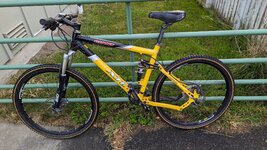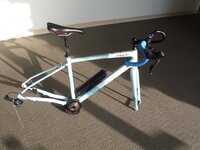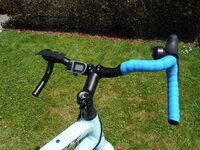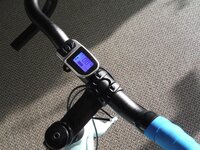Hello all. I am looking into the idea of getting a road or gravel bike with an 'e' assist to help with climbing more severe hills (there are many 6-12% hills in my area and if I can't climb them then my route choices are severely limited) but that can then be turned off the rest of the time. Because of this the battery doesn't have to be very large since its not running all the time and the system should be as discrete as possible without a big, obvious battery hanging out. Two that I'm looking into are the Trek Domane+ ALR4 and Salsa Confluence. Both have geared rear hub motors in the 250w class (and 40Nm) and small batteries. I am wondering if this style and power level of motor is truly suited for my intended purpose or should I look instead for a mid-drive system? The later from my research tend to cost a lot more and then become out of my price range. Any thoughts? Suggestions?
You are using an out of date browser. It may not display this or other websites correctly.
You should upgrade or use an alternative browser.
You should upgrade or use an alternative browser.
Hub- vs. mid-drive for e-gravel/road bikes
- Thread starter BG213
- Start date
Chargeride
Well-Known Member
The problem with hub is the steeper the hill ,the slower you go and the motor becomes less effective and you're losing battery to heat rather than drive.
Also removing rear wheel is far more of a palaver.
Once you mention hills, Im going to recommend mid drive.
There are lots of new ultralights coming out, but the prices are ridiculous.
If you are strong enough to keep a hub above 10mph on a steep hill it will be OK., if not, mid drive is the one
Also removing rear wheel is far more of a palaver.
Once you mention hills, Im going to recommend mid drive.
There are lots of new ultralights coming out, but the prices are ridiculous.
If you are strong enough to keep a hub above 10mph on a steep hill it will be OK., if not, mid drive is the one
mrgold35
Well-Known Member
- Region
- USA
- City
- ABQ, New Mexico
I think I would lean toward to "I rather have it and not need it, compared to need it and not have it". I like a tq sensor mid-drive+throttle with the max tq and max battery size within my budget. Long term battery life can be reduced with more charge cycles. You can have less long-term battery life with fully recharging a smaller battery pack everyday compared to every 3rd-4th day with a larger battery pack for exact same X amount of miles. Unless there are local restrictions, I don't think I've heard ebikers say: "my ebike has too much power and I wish it had 40%-60% less tq and battery life".
I do find the extra power/battery life does come in handy in certain conditions to extend riding days closer to 365 days:
- extreme cold: reduced battery life with below freezing temp
- extreme heat of +95 degree F: I can up the PAS levels to ride faster to cool me off better
- wind: I can up the PAS levels to ride in 15-25 mph windy days that would sideline most pedal bikes
- less worry: no range anxiety or needing to recharge or needing a second battery on an extended rides of +/- 30 miles (enough power/battery life with extreme weather conditions with extended rides)
- flexibility: the extra power/battery life comes in handy if you need to ride and not be overheated and sweaty when you reach your destination (morning work commuting or weekend fun ride to another activity or restaurant).
I do find the extra power/battery life does come in handy in certain conditions to extend riding days closer to 365 days:
- extreme cold: reduced battery life with below freezing temp
- extreme heat of +95 degree F: I can up the PAS levels to ride faster to cool me off better
- wind: I can up the PAS levels to ride in 15-25 mph windy days that would sideline most pedal bikes
- less worry: no range anxiety or needing to recharge or needing a second battery on an extended rides of +/- 30 miles (enough power/battery life with extreme weather conditions with extended rides)
- flexibility: the extra power/battery life comes in handy if you need to ride and not be overheated and sweaty when you reach your destination (morning work commuting or weekend fun ride to another activity or restaurant).
indianajo
Well-Known Member
I cross 77 hills in my 30 mile commute with my geared hub drive. It will accelerate me +20 lb tools/supplies+60 lb groceries to 10 mph up 15% grade with no help from me. I tend to maintain speed from the previous downhill and average much higher speed. The unpowered drag is so low I do not remove it in winter when the battery stays in the garage in town. Both a 1300 w ebikeling geared hub and a 1000 w Mac12t have this capability.Once you mention hills, Im going to recommend mid drive.
Mid-drives tend to drag the motor with your feet unpowered. Exception shimano steps, yamaha, and brose. The most expensive of 4 models of bosch has this slip clutch.
What a geared hub drive will not do is grind up a hill at 5 mph for an hour or more. It will overheat and burn the winding. Do not buy a geared hub motor for climbing the Rocky or Sierra mountains. A 350 w bafang geared hub was inadequate to my needs in So Indiana and I did burn the winding on that one even though my hills are rollers. It was overvolted, 48 v on a 36 v motor, which was feeble on 36 v.
Battery size, the more the better IMHO. The wind was predicted to be from my right side yesterday. However it was actually 18 mph in my face with gusts to 24 mph. I used much more battery than usual into that wind, running my 840 wh 48 v battery down from 53.8 v to 49.2 in 30 miles and 4 hours. No cargo that leg back into town. You may live in the horse latitudes like Houston, where there is never wind except during hurricanes. Here, there are much higher and more frequent winds than even in 2017. With wind <12 mph in my face I ride unpowered 80% of the distance, using battery only for about 20 of the later hills. Even this very large battery sometimes drops out the controller (below minimum volts) on some of the steepest hills on the uphill leg. When I get to destination the battery will read 46 v, but went below 40 v up a 12 % hill at full assist 3 miles from destination. This battery is 5 years old, about 500 charges. Note this is my second motor; the gears in the ebikeling wore out at ~4500 miles. New geared hub motors are $300-600, and the bike is not in the shop for a month waiting for parts like a mid-drive. I keep a spare motor in a wheel in the garage for 1 day changeout. The ebikeling motor was rideable unpowered with the bad gears. I just rode it to destination unpowered, then 3 days later back home again.
BTW my geared hub motor is on the front, not the rear. This balances a cruiser style bike much better. Since it is a conversion, I left slack in the wire harness down the fork to remove the wheel without unplugging it. I changed a flat in a pouring rain 2 weeks ago in 30 minutes, including 5 minutes to remove and reattach because I had trapped the brake cable under the wheel nuts. You cannot buy a bicycle this way, except some obsolete brand beginning with F. When I did have a DD 1000 w rear hub motor, I could never find a 8 speed freewheel that would fit the forks, nor any 7 speed freewheel with 13-32 sprockets. 28 tooth max was in stock in the US.
Last edited:
jabberwocky
Well-Known Member
Main issue with a hub motor is that your powered drivetrain is singlespeed. So theres no ability to adjust powered gearing through the bikes drivetrain to accommodate different road conditions or grades. Advantage is they are mechanically simpler and therefore less expensive. Some mfgs try and overcome that disadvantage by just throwing power at it (bigger motor and more wattage certainly helps with the hill power). Disadvantage of that approach is weight and cost (obviously bigger motor requires more battery and beefier controller which weigh and cost more).
Another consideration is how bike-like you want your ebike to feel. Almost always, a mid drive with torque sensing is going to give you the ebike that feels most like pedaling a non-electric.
I do think the Domane ALR is a mid drive, using Fazuas low power system. May not be true across the world and all the ALR models.
Another consideration is how bike-like you want your ebike to feel. Almost always, a mid drive with torque sensing is going to give you the ebike that feels most like pedaling a non-electric.
I do think the Domane ALR is a mid drive, using Fazuas low power system. May not be true across the world and all the ALR models.
indianajo
Well-Known Member
Ha Ha Ha Ha Ha!.Main issue with a hub motor is that your powered drivetrain is singlespeed. So theres no ability to adjust powered gearing through the bikes drivetrain to accommodate different road conditions or grades.
Electric motors can turn 10000 rpm or more in dentists drills. With 5 to 1 gears, a hub motor rotor spins about 1100 rpm at 25 mph. Easy. My 12 winding geared hub reaches a torque max about 5 mph. (most geared hubs are 10 winding). If I wanted to go 40 mph I might want a mid drive to allow the back wheel to turn faster than the motor sprocket. But I do not want to go that fast on a bicycle. I broke my jaw at 25 mph with no motor at all.
PedalUma
Well-Known Member
- Region
- USA
- City
- Petaluma, CA
You need a mid-drive. It will pull chain through the shiftable gears. All it takes are a gravel/adventure bike, a motor, and a battery.12% hills in my area
Attachments
m@Robertson
Merciless (on the inside)
- Region
- USA
@jabberwocky, @Chargeride and @PedalUma are all correct. Gears are used to make the bike easier to pedal up a hill, and with a motor in the drivetrain, they benefit the motor the same way they do your legs. Anyone can test this on any bike by leaving it in one gear - say a 16T cog in back to be comparable to a typical hub motor - and try and go up one of those 6-12% grades without shifting. Easy lesson to learn.
But don't believe anyone here, how about? Someone is wrong... but who? Watch this video of a 14 ebike test. All hub motors. All up a fairly long, steep hill. All tested repeatably and throttle only so we are just seeing the hub motor+bike being tested. You will know what you can expect with a hub motor and a hill after watching this.
As noted, the solution is to use a gigantic hub that is in the 3000w+ range. A trick @jabberwocky didn't mention is the use of 20" tires, which provide a torque advantage. But you can see several in the vid and judge for yourself whether a legal motor with a small wheel is going to be something you want to consider.
Hub motors are great in some ways. Hills just aren't one of them.
But don't believe anyone here, how about? Someone is wrong... but who? Watch this video of a 14 ebike test. All hub motors. All up a fairly long, steep hill. All tested repeatably and throttle only so we are just seeing the hub motor+bike being tested. You will know what you can expect with a hub motor and a hill after watching this.
As noted, the solution is to use a gigantic hub that is in the 3000w+ range. A trick @jabberwocky didn't mention is the use of 20" tires, which provide a torque advantage. But you can see several in the vid and judge for yourself whether a legal motor with a small wheel is going to be something you want to consider.
Hub motors are great in some ways. Hills just aren't one of them.
jabberwocky
Well-Known Member
But don't believe anyone here, how about? Someone is wrong... but who? Watch this video of a 14 ebike test. All hub motors. All up a fairly long, steep hill. All tested repeatably and throttle only so we are just seeing the hub motor+bike being tested. You will know what you can expect with a hub motor and a hill after watching this.
I've also seen hub motor MTB tests where even with monstrous, multi-thousand watt hub motors the bikes struggled at slow speeds on a steep enough slope (especially in rough terrain). Electric motors have a very flat torque curve but they still stall and struggle at very low RPM, like you'll see on unpaved trails and roads.
A trick @jabberwocky didn't mention is the use of 20" tires, which provide a torque advantage. But you can see several in the vid and judge for yourself whether a legal motor with a small wheel is going to be something you want to consider.
True, because a smaller wheel effectively reduces your overall gearing (something recumbent riders are familiar with, since many recumbents use smaller drive wheels). Geared hub motors also help by using an internal gearbox to reduce the overall gearing the motor sees, moving the effective RPM range down.
PedalUma
Well-Known Member
- Region
- USA
- City
- Petaluma, CA
That drop bar Felt gravel adventure is the only one I have heard of that is all through frame and has a torque sensor with a throttle. Normally throttle bikes have bulky wires and as many connectors as a farm dog with fleas. I put the thumb throttle on the inboard side of the lever hood. Who ever smelt it, Felt it.
Attachments
Stefan Mikes
Gravel e-biker
- Region
- Europe
- City
- Mazovia, PL
My gravel cycling experience is the mid-drive motor (even with a low nominal torque) backed with gearing adequate for the terrain ridden is the only appropriate way for serious gravel riding, especially with rough terrain or hills involved.
bchester12
New Member
- Region
- USA
Having both now, I would say like everyone else - Depends on the terrain.Hello all. I am looking into the idea of getting a road or gravel bike with an 'e' assist to help with climbing more severe hills (there are many 6-12% hills in my area and if I can't climb them then my route choices are severely limited) but that can then be turned off the rest of the time. Because of this the battery doesn't have to be very large since its not running all the time and the system should be as discrete as possible without a big, obvious battery hanging out. Two that I'm looking into are the Trek Domane+ ALR4 and Salsa Confluence. Both have geared rear hub motors in the 250w class (and 40Nm) and small batteries. I am wondering if this style and power level of motor is truly suited for my intended purpose or should I look instead for a mid-drive system? The later from my research tend to cost a lot more and then become out of my price range. Any thoughts? Suggestions?
But overall, rear motor for comfort - The motor pushes you , its a nice feeling and quickly reaching 20mph is no sweat at all. Hill strategy - Don't slow down - That is keep your cadence up you will be fine except the sudden hills when you cannot keep your tempo. I was frustrated by the speed limit of 20pmh ( it was so easy to reach that speed) and alloy frame - It was breaking my bones on long 30+ miles rides.
Mid drive - You need to work here.. no magic carpet like feeling. You can be consistent on 28+ mph but lot of work is involved. Carbon frame took out the sting from the long rides.
Summary - Rear motor for grocery and cafe rides.
Mid motor for going anywhere- fast , but ready to sweat a lot.
JRA
Well-Known Member
I gifted my son two ebikes over the last few years. One is a hardtail mid drive with a TSDZ2 motor and the other is what is called a gravel bike these days I suppose with a dd front hub motor. He has come to the same conclusion that I did over the years that a hub motor bike is better for road use and mid drive for trail use. He lives in Vancouver, B.C. and uses his bike to get to work and out of the city to get to his fishing holes in the outskirts. So he mostly uses the road type bike as it stands.
I set up a hub motor to not include PAS into the program but rather have a throttle that can be set to whatever wattage is required. This allows for pedaling of the bike naturally and a more consistent cadence by not including motor power into the drive train itself. Whereas a more trail oriented bike with a lower cadence generally and more on/off pedaling and inconsistent speeds a torque assist works much better.
I set up a hub motor to not include PAS into the program but rather have a throttle that can be set to whatever wattage is required. This allows for pedaling of the bike naturally and a more consistent cadence by not including motor power into the drive train itself. Whereas a more trail oriented bike with a lower cadence generally and more on/off pedaling and inconsistent speeds a torque assist works much better.
gromike
Well-Known Member
- Region
- USA
- City
- City of Dreams
A really light rear hub motor that you can throw a lot of amps into would be a really great trail bike, but if you want that performance for less than Grin prices it would be a mid-drive. I have a TSDZ2b and a BBSO2 and hands down it is the Bafang. Though my TSD is at only 36v, and the Bafang is at 52v. I don't have a problem with ghost pedaling with the non-torque sensing BBSO2. With 5 PAS levels and 8 gears it works great. My favorite bike, though, is a torque sensing, regen braking Grin rear hub motor, but that motor and controller are now migrating into this:



6zfshdb
Well-Known Member
- Region
- USA
- City
- Northeast Pennsylvania
As others have said, when it comes to frequent steep hill climbing, a mid drive is the way to go.
My only issue with mid drives is, the selection of bikes with a throttle is much more limited than hub drives. For health reasons, a throttle is a must for me.
My only issue with mid drives is, the selection of bikes with a throttle is much more limited than hub drives. For health reasons, a throttle is a must for me.
jabberwocky
Well-Known Member
My favorite bike, though, is a torque sensing, regen braking Grin rear hub motor, but that motor and controller are now migrating into this:
Oh man, an old Giant XTC with their NRS (no resonance system) linkage! Those were unique bikes. The NRS linkage was designed to run with minimal sag and give a hardtail feel under normal conditions with some suspension for the hard hits. Gotta be an early 2000s model. That suspension was super finicky to tune and did ride harsh (I started mountainbiking around then and had several riding friends with NRS Giants). Some of them joked that NRS actually stood for "no rear suspension".
Similar threads
- Replies
- 10
- Views
- 3K
- Replies
- 29
- Views
- 10K
- Replies
- 1
- Views
- 1K


